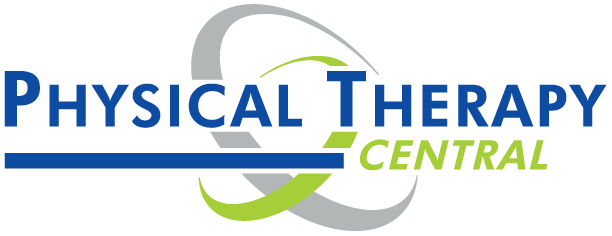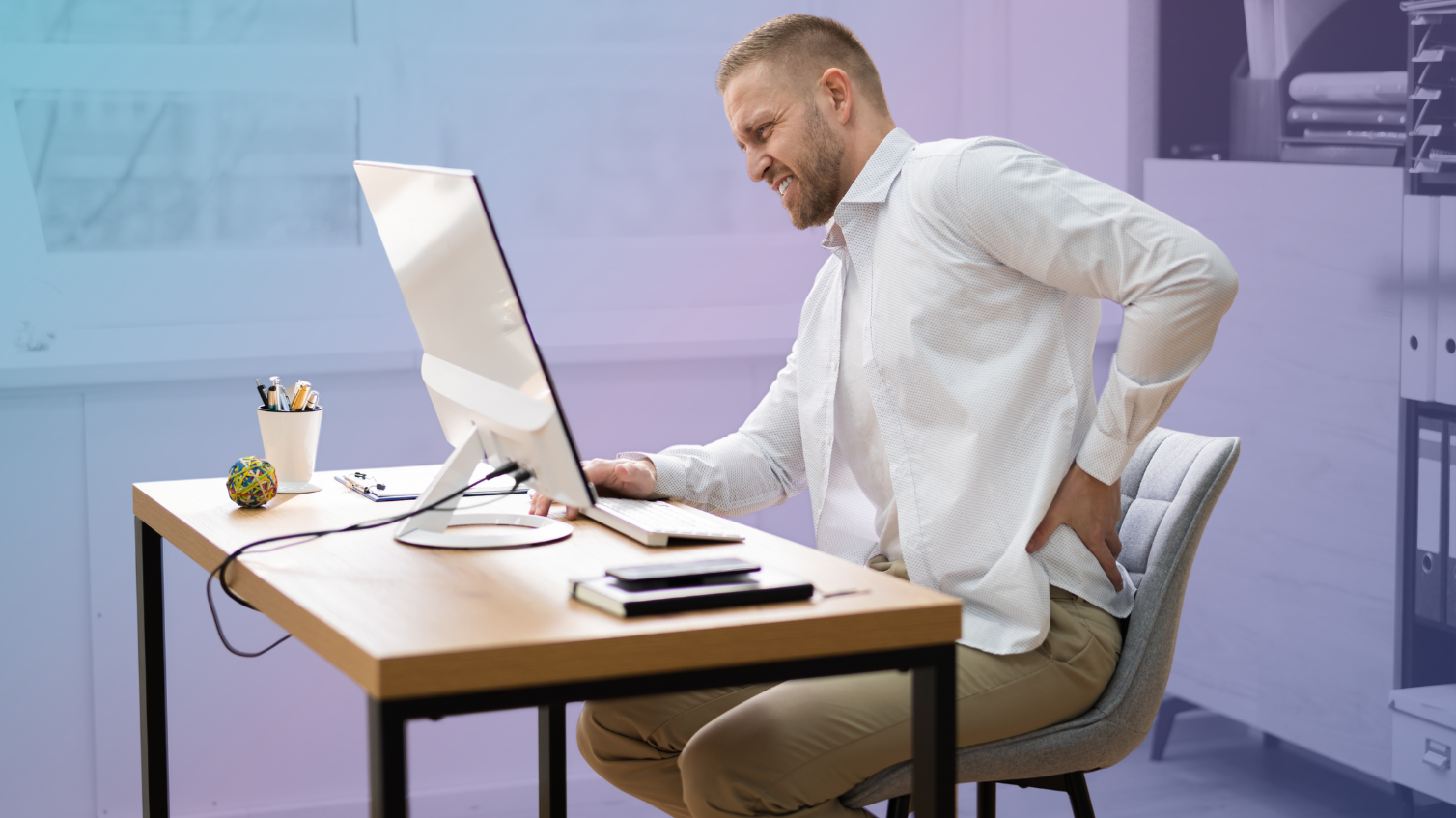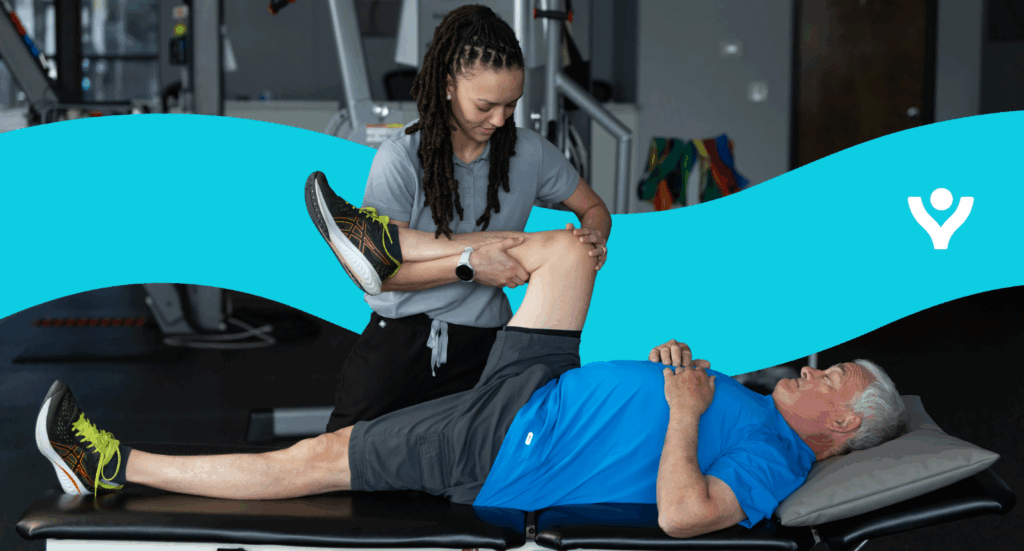If you work a desk job, you may be familiar with the sensation of dead butt syndrome or gluteal amnesia. “Dead butt syndrome is essentially a condition in which your gluteal muscles become inactive or weak due to sustained periods of sitting or inactivity. It’s the result of your gluteal muscles basically forgetting how to work,” explained Dr. Devin Trachman, PT, DPT, MTC, OCS, Clinic Director of Physical Therapy Central’s Edmond West Clinic. “Common activities such as standing upright, walking, squatting, standing up, using the stairs, and so many other normal activities become much more challenging, requiring your body to develop compensatory movement patterns to perform these movements despite little to no participation from your glutes.”
If this sounds familiar, keep reading to learn more about dead butt syndrome and how to get rid of it.
Dead Butt Syndrome Symptoms
If you have dead butt syndrome, you have difficulty engaging your gluteal muscles during physical activity. Since you can’t engage these muscles, you may have trouble transitioning from sitting to standing or performing squats. This can lead people to develop compensatory patterns that place increased stress on other muscles and joints in the body, according to Dr. Trachman. If this is the case, Dr. Trachman sees many patients with gluteal weakness who report low back and hip pain. Other symptoms include:
- Numbness and/or soreness in the glute and hip region
- Pain and/or stiffness with prolonged sitting
- Decreased strength in the gluteal muscles and hip flexors
- Sciatic or radiating pain symptoms down the leg
- Tightness in hip flexors
- Poor posture
- Reduced strength in the abdominals
- Pain in distal joints, including the hip, knee, and/or ankle
What Causes Dead Butt Syndrome?
The quick answer? A sedentary lifestyle. “It can develop from long hours spent sitting – including working at a desk sitting, then a long commute in the car, followed by the rest of the day and night spent sitting on the couch,” explained Dr. Trachman. Poor posture can also lead to dead butt syndrome as it places additional stress on the hips and pelvis, “creating muscle imbalances with hip flexor dominance and decreased glute activation.”
Avoiding movements or workouts that work the glutes can lead to your brain “forgetting” how to activate those muscles. “When your gluteal muscles are not being activated with activities of normal living like walking, squatting, or taking the stairs, your brain can “forget” how to effectively activate these muscles,” said Dr. Trachman.
Activate Your Gluteal Muscles
Dr. Trachman listed her three favorite gluteal exercises that can help you treat dead butt syndrome.
Clamshell
- Begin by lying on your side with the side you intend to exercise upwards.
- With your knees bent and feet together, slowly pull your knees apart, keeping your feet together.
- Hold as directed.
- Slowly bring your knees back together.
- Repeat 2-3 sets of 10 reps on each side.
Progress this move into a side plank clamshell.
- Lie on your side with your leg to be exercised on top and an exercise band around your thighs.
- Bend the elbow of the arm closest to the mat to 90 degrees and rest it underneath your shoulder.
- Bend both knees to 90 degrees.
- Slowly push up through your knees and your elbow so your body comes off the mat.
- Slowly move the top knee up and away from the bottom knee, keeping your feet together.
- Bring your leg back to the starting position. Repeat two sets of 10 reps on each side.
Bridge
- Begin by lying on your back with your knees bent, both feet on the floor, and your arms at your sides.
- Tighten your abdominals by drawing your belly button toward your spine.
- Keeping the stomach tight, raise your hips off the surface by squeezing your gluteal muscles.
- Attempt to bring the hips up as far as possible while maintaining the abdominal contraction.
- Return to the starting position.
- Repeat three sets of 10 reps.
Progress this move into a single-leg bridge.
- Begin lying on the floor, palms on the floor, with one knee bent directly under the foot.
- Slowly lift your hips and back off the floor until the straight knee aligns with the bent one.
- Hold 10 seconds and slowly lower back down.
- Repeat 2-3 sets of 10 reps on each side.
Make this even more challenging by adding a march with the single-leg bridge.
- Begin on your back, knees bent hip-distance apart, and arms and feet on the floor.
- Press your hips up towards the ceiling, then lift one knee straight up, lower it, and repeat with the other leg, keeping your hips in line at all times.
- Repeat 2-3 sets of 10 reps on each side.
Hip Extension
- Standing hip extension
- Begin standing on flat ground or a small box if available.
- Place one hand on a railing or piece of stable furniture for stabilization.
- Squeeze your glute as you move the leg backward while keeping the knee straight.
- Do not lean forward or arch your back.
- Slowly lower back to the starting position.
- Repeat 2-3 sets of 10 reps on each side.
Quadruped hip extension
- Begin in the quadruped ‘all fours’ position.
- Engage your core and lift one leg straight backward until it is straight, in line with your trunk.
- Focus on activating your glute muscles.
- Return to the starting position and alternate legs.
- Tip: do not let your back arch. Keep your neck in neutral with a light chin tuck.
- Repeat two sets of 10 reps on each side.
Quadruped fire hydrant
- Begin in the quadruped position (on hands and knees, hips over knees, shoulders over hands and spine neutral).
- Keep your core engaged as you slowly pivot one knee back and outward as far as possible without rotating your trunk.
- Focus on pivoting from your hip and using your glutes to perform the exercise.
- Maintain a bent knee as you perform the exercise.
- Repeat as prescribed.
- Tip: Keep your neck neutral by holding a slight chin tuck throughout the exercise.
- Repeat two sets of 10 reps on each side.
Schedule an Appointment
If you’re experiencing dead butt syndrome or have pain in your lower back or hip, we recommend scheduling an appointment with a Physical Therapy Central physical therapist. Your health and safety are our top priorities, and we can address the root cause of the pain before it gets worse. For the full article, please follow this link: Wait, Do You Have Dead Butt Syndrome?



